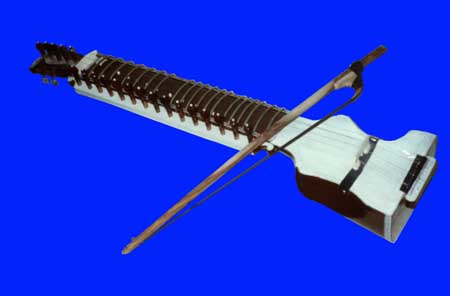| |
Dilruba is a cross between the sitar and sarangi. It is
extremely close to the esraj and the mayuri vina. It so close that
most people are unable to tell them apart. The difference is to be
found in the shape of the resonators and the manner in which the
sympathetic strings attach. Still they are so similar that a dilruba
player has no trouble playing an esraj or a mayuri vina and vice
versa. is to be
found in the shape of the resonators and the manner in which the
sympathetic strings attach. Still they are so similar that a dilruba
player has no trouble playing an esraj or a mayuri vina and vice
versa.
The construction is very interesting. The neck has approximately 18
strings. The approach to tuning is somewhat similar to the sitar.
Like the sitar, almost all of the playing is performed upon only one
string. There are a number of metallic frets, some of which will be
moved according to the requirements of the rag. It has a series of
sympathetic strings which are tuned to the notes of the rag.
The dilruba is popular in north-west India. It is found in Punjab,
Uttar Pradesh and Maharashtra.
TECHNIQUE - The technique is also a cross between the sarangi and
the sitar. It is bowed with a bow (known as gaz) in a manner very
much like the sarangi. It is bowed with the right hand while the
left hand fingers the strings.
There seem to be two schools concerning the fingering of the dilruba.
One approach shows a strong influence of the sitar. For this
approach, there is a strong preference given to using the index
finger. Like the sitar, one occasionally invokes the middle finger
to gain speed. This approach seems to be slightly more common in
North Eastern India. The other school of seems to show a distinct
preference to the use of the middle finger coupled with the index
finger. This approach seems to have the advantage that if one
requires speed, one can occasionally use either the index or the
ring finger to go in either direction. It is interesting to note
though that the proponents of the this school seem to be less
disposed to invoke such shortcuts to their technique.
In either case, one does not solidly lock the string against the
fret as one would do with the sitar or most other fretted stringed
instruments. One only has to lightly touch the fret against the
string. This allows one to alter the intonation with ease. One has
no problem raising or lowering the pitch at the fret simply by where
on the fret you wish to place the finger. In short, we can think of
the frets of the dilruba as being mere guides for correct finger
placement.
The layout of the strings of the dilruba is very similar to the
sitar. This is shown in the illustration to the right. However
unlike the sitar, there is no need to move the frets whenever one is
playing a note that does not have a fret (e.g., Komal Re or Komal
Dha in the middle register.) When one needs to play these notes, one
merely has to place the finger in the appropriate point midway
between the frets.
The meend is also produced in a fashion very differently from the
sitar. For the dilruba, one need only slide the fingers up and down
along the string in order to produce a meend or any other ornament,
where on the sitar one pulls the string laterally across the fret.
|
|

 is to be
found in the shape of the resonators and the manner in which the
sympathetic strings attach. Still they are so similar that a dilruba
player has no trouble playing an esraj or a mayuri vina and vice
versa.
is to be
found in the shape of the resonators and the manner in which the
sympathetic strings attach. Still they are so similar that a dilruba
player has no trouble playing an esraj or a mayuri vina and vice
versa.